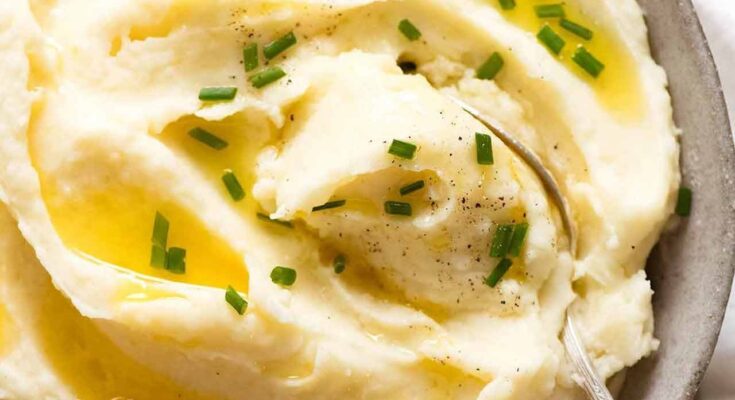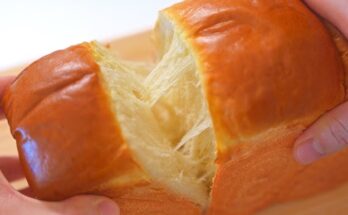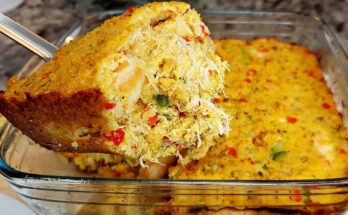Creamy Mashed Potatoes Recipe: There’s something universally comforting about a bowl of rich, creamy mashed potatoes.
Whether it’s the star of a holiday dinner or just a side dish on a regular weekday, mashed potatoes have a way of making everything feel a little more like home. But achieving that perfect creamy texture? That’s where the magic—and the technique—comes in.
This step-by-step guide will walk you through every detail to create mashed potatoes that are smooth, buttery, and undeniably delicious.
Introduction to the Perfect Mashed Potatoes
Mashed potatoes are one of those timeless dishes that show up on dinner tables all across the world. They’re creamy, soft, fluffy, and full of flavor when done right. But have you ever ended up with lumpy, gluey, or bland mashed potatoes and wondered what went wrong? It all comes down to technique, choice of ingredients, and just a little bit of love.
In this guide, we’re diving into the art of making perfect mashed potatoes every single time. Whether you’re cooking for two or preparing a feast, you’ll learn how to master this side dish and impress everyone at the table. We’ll explore everything from selecting the right potatoes to seasoning like a pro. Get ready to ditch the boxed stuff and take your mash game to the next level.
Ingredients You’ll Need
Before we get our hands dirty, let’s go over the ingredients. Simplicity is key here—mashed potatoes don’t need a long list of items to shine. Here’s what you’ll need for a basic, creamy version:
Basic Ingredients:
- 2 pounds of Russet or Yukon Gold potatoes
- 4 tablespoons unsalted butter (room temperature)
- ½ cup heavy cream or whole milk (warmed)
- Salt (to taste)
- Freshly ground black pepper (to taste)
Optional Add-Ins for Extra Flavor:
- 2 cloves garlic (minced or roasted for a mellow flavor)
- ½ cup sour cream for a tangy twist
- 1 cup shredded cheese (cheddar, parmesan, or gouda)
- Fresh chives or parsley for garnish
The beauty of mashed potatoes lies in their adaptability. You can dress them up or down, depending on the occasion or your mood. Want a little heat? Add some horseradish or cayenne pepper. Craving richness? Double up on the butter and cream.
Choosing the Right Potatoes
Not all potatoes are created equal—especially when it comes to mashing. If you want that dreamy, smooth consistency, you have to start with the right spuds.
Best Types for Mashing:
- Russet Potatoes – These are high in starch and low in moisture, making them ideal for fluffy, smooth mashed potatoes. They break down easily and absorb butter and cream like a sponge.
- Yukon Gold Potatoes – Slightly waxier than Russets but still creamy when mashed. They have a naturally buttery flavor that enhances the final dish.
Avoid using red potatoes or new potatoes if you’re after creamy mash—they tend to be too waxy and hold their shape, which can lead to a gummier texture when mashed.
A pro tip? Use a mix of Russet and Yukon Golds. You’ll get the best of both worlds: the fluffiness of Russets with the rich, buttery flavor of Yukons.
Step-by-Step Preparation Guide
This is where the magic happens. Follow these steps closely, and you’ll end up with the silkiest, creamiest mashed potatoes you’ve ever tasted.
Step 1: Peel and Cut the Potatoes
Peel your potatoes and cut them into even chunks—about 1.5 to 2 inches thick. Uniform pieces cook evenly, preventing some bits from turning mushy while others remain undercooked.
Place the cut potatoes in a large pot and cover them with cold water. Starting with cold water ensures the potatoes cook evenly from the inside out.
Step 2: Boil to Perfect Softness
Add a generous pinch of salt to the pot (just like pasta water!) and bring it to a boil. Reduce to a gentle simmer and cook the potatoes for 15-20 minutes or until they’re fork-tender. You should be able to easily pierce them with a fork with no resistance.
Drain the potatoes in a colander once they’re done. Be gentle to avoid breaking them apart too much during transfer.
Step 3: Drain and Dry the Potatoes
This step is often skipped, but it makes a huge difference. Return the drained potatoes to the hot pot and place them over low heat for 1-2 minutes. Stir occasionally to let any residual water evaporate. This helps the potatoes absorb the butter and cream better, leading to a more luscious texture.
Step 4: Mash the Potatoes the Right Way
Use a potato masher for a more rustic texture, or a potato ricer if you want ultra-smooth mashed potatoes. Avoid using a blender or food processor—they’ll overwork the starches and give you gluey, sticky results.
Mash gently, just until smooth. Overmixing can ruin the texture.
Step 5: Add Butter, Cream, and Seasoning
This is where the flavor comes in! Add your room-temperature butter first and let it melt into the hot potatoes. Then slowly mix in your warmed cream or milk until you reach your desired consistency. Season with salt and pepper to taste.
Don’t be shy with the butter—this is mashed potatoes, not a diet dish. The creaminess and richness are what make it irresistible.
Pro Tips for Extra Creamy Mashed Potatoes
Want to know the secrets behind restaurant-quality mashed potatoes? It’s all in the details. These pro tips will make sure your mashed potatoes are as luscious and creamy as possible every single time.
1. Warm Everything Up
One of the biggest mistakes home cooks make is adding cold butter or milk straight from the fridge. This shocks the potatoes and causes them to stiffen. Instead, warm the cream and let the butter come to room temperature before adding. This helps everything blend smoothly without clumping or cooling the potatoes.
2. Don’t Skip the Drying Step
We mentioned it before, but it’s worth repeating: drying the potatoes in the pot after boiling helps remove excess water, which would otherwise dilute your creamy additions. This step helps the potatoes absorb the butter and cream better, intensifying the flavor and richness.
3. Go Easy on the Mixing
The more you stir, the more the starch gets activated—and that’s a surefire way to end up with gummy, gluey potatoes. Mash gently and stir just enough to combine the ingredients.
4. Butter is Your Best Friend
The key to luxurious mashed potatoes? Generous amounts of butter. Don’t skimp—it’s what gives your potatoes that velvety, indulgent feel.
5. Taste and Adjust
Every batch of potatoes is different. Some need more salt, others may need a bit more cream. Always taste as you go and adjust the seasoning. You can even add a splash of sour cream or a pinch of garlic powder if you’re feeling fancy.
Creative Variations of Mashed Potatoes
Mashed potatoes don’t have to be plain. Sure, the classic version is unbeatable, but adding a few ingredients here and there can turn this side dish into a showstopper.
1. Garlic Mashed Potatoes
Add roasted or sautéed garlic cloves while mashing. Roasted garlic offers a sweet, mellow flavor that blends perfectly with the creaminess.
2. Cheesy Mashed Potatoes
Mix in shredded cheddar, gouda, or parmesan for a rich, cheesy twist. Just be sure the cheese is melted evenly—grate it finely for the best result.
3. Herb-Infused Mashed Potatoes
Add chopped fresh herbs like parsley, chives, rosemary, or thyme. These bring color and freshness to your mash.
4. Sour Cream & Onion Mash
Add sour cream for tang and stir in caramelized onions for a flavor bomb that tastes just like your favorite chip dip—only creamier!
5. Bacon & Cheddar Mash
Crispy bacon bits and sharp cheddar cheese take mashed potatoes into comfort food heaven. Perfect for topping with a sprinkle of scallions.
Customizing mashed potatoes is part of the fun. You can even try truffle oil for a gourmet spin or use Greek yogurt for a healthier take. Don’t be afraid to experiment—you might just stumble upon your new signature mash.
Best Dishes to Serve With Mashed Potatoes
Mashed potatoes are like the best supporting actor in your kitchen—always making the main dish shine. Here are some perfect pairings that go hand-in-hand with a creamy mash.
1. Roast Chicken or Turkey
This is the classic combo—especially around the holidays. The savory gravy from a well-roasted bird poured over fluffy mashed potatoes? Pure bliss.
2. Meatloaf
Another comfort food favorite. Mashed potatoes and meatloaf go together like peanut butter and jelly. Add some green beans on the side for the full nostalgic effect.
3. Beef Stew
Thick, hearty stews with tender chunks of meat are perfect over a bed of mashed potatoes. The potatoes soak up the rich sauce, creating layers of flavor in every bite.
4. Grilled Sausages
In Britain, this combo is called “bangers and mash”—and it’s as delicious as it sounds. Add a bit of onion gravy for the full experience.
5. Vegetarian Options
Mashed potatoes also pair beautifully with roasted mushrooms, sautéed greens, lentil loaf, or even crispy tofu. Their creamy texture balances out the crispiness of veggie-based dishes.
Mashed potatoes are incredibly versatile, making them the perfect side for just about any main dish, whether it’s meat-based or plant-powered.
Storage and Reheating Tips
Got leftovers? Lucky you! Mashed potatoes store well, but there are a few tricks to keeping them creamy and delicious when reheated.
1. Store in an Airtight Container
Transfer your mashed potatoes to a container with a tight-fitting lid. Press plastic wrap directly on the surface of the mash to prevent a crust from forming.
2. Refrigerate Promptly
Let the mash cool slightly, then pop it into the fridge within two hours of cooking. They’ll keep for up to 4 days.
3. Reheat Gently
When you’re ready to reheat, place the mashed potatoes in a saucepan over low heat. Stir frequently, and add a splash of milk or cream to loosen them up. You can also reheat in the microwave in 30-second bursts, stirring in between.
4. Freeze for Longer Storage
Yes, mashed potatoes can be frozen! Scoop them into portions and place them in freezer-safe containers or zip bags. To thaw, leave them in the fridge overnight and reheat using the methods above. Just be mindful: the texture may change slightly, so always stir in a bit more cream or butter to bring them back to life.
Proper storage and reheating make it easy to enjoy mashed potatoes all over again—whether as a side dish, a topping for shepherd’s pie, or a quick lunch.
Common Mistakes to Avoid
Even with the best ingredients, a few wrong moves can lead to mashed potato disasters. Let’s avoid those with some common-sense tips:
1. Overmixing
We’ve said it before, and we’ll say it again: don’t overwork the potatoes. This activates the starches and turns them into a gluey mess.
2. Using Cold Dairy
Cold butter and milk don’t mix well with hot potatoes. They cool the mash and make it harder to blend smoothly.
3. Underseasoning
Potatoes are naturally bland, so don’t be shy with the salt. Season the boiling water and taste as you mash.
4. Not Drying the Potatoes
Boiling and draining isn’t enough. That quick extra step of drying the potatoes over heat removes excess moisture and keeps your mash rich and thick.
5. Choosing the Wrong Potatoes
Stick with high-starch potatoes like Russets or Yukon Golds. Waxy varieties just won’t give you that melt-in-your-mouth texture.
Avoiding these mistakes is half the battle. Get these basics right, and you’ll be the mashed potato master in no time.
FAQs about Creamy Mashed Potatoes Recipe
Q1: What’s the best type of potato for creamy mashed potatoes?
A: Yukon Gold or Russet potatoes are your best bet. Yukon Golds are naturally buttery, while Russets give that classic fluffiness.
Q2: Can I make creamy mashed potatoes ahead of time?
A: Absolutely. Just reheat gently with a splash of milk or cream, and stir until smooth.
Q3: How do I avoid lumpy mashed potatoes?
A: Boil until fork-tender, then mash while hot using a ricer or hand masher. Don’t overmix—unless gluey is your goal.
Q4: What makes mashed potatoes “creamy”?
A: The magic mix: warm cream, butter, and proper mashing. Cold dairy is a no-no—it can make your mash stiff.
Q5: Can I use milk alternatives?
A: Yes! Try unsweetened almond milk, oat milk, or coconut milk for a dairy-free twist—just watch for added flavors.
Q6: Is it okay to leave the skin on?
A: Totally a personal call. Skin-on mashed potatoes are rustic and fiber-rich. Peel them if you’re going for ultra-smooth.
Q7: How do I store leftovers?
A: Keep them in an airtight container in the fridge for up to 4 days. Reheat on the stove or microwave with a splash of liquid.
Q8: Can mashed potatoes be frozen?
A: Yes, but with caution. Freeze in portions and reheat with extra butter or cream to revive the texture.
Q9: How much mashed potatoes should I make per person?
A: Plan for about 1/2 cup to 3/4 cup per person. Holiday crowd? Double it—trust us.
Q10: What’s the best way to add extra flavor?
A: Roasted garlic, sour cream, cream cheese, chives, or even a pinch of nutmeg—go wild, just don’t skimp on the butter.
Conclusion
Feel free to get creative with flavors—add garlic, herbs, cheese, or even bacon if you’re feeling bold. Mashed potatoes are like a blank canvas, ready for your signature twist. And don’t forget: leftovers can be just as delightful the next day with a little love and reheating magic.
So next time you’re planning a meal, go all in on your mashed potatoes. When made right, they don’t just complement a dish—they elevate the whole dining experience.



